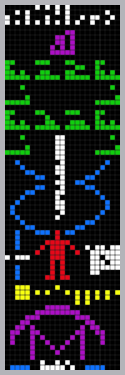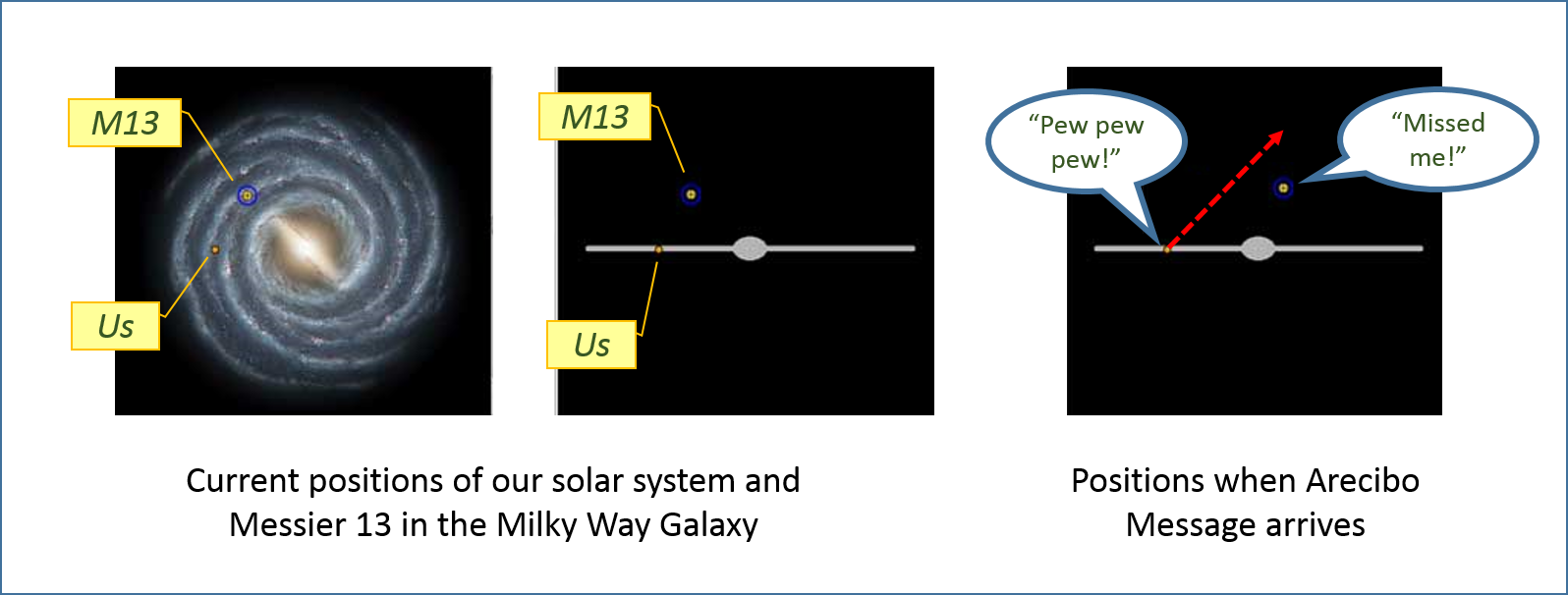Weird Alien Communication: The Arecibo Message
Whoopsie…
Back in 1977, we earthlings sent our very first message out into space — the original attempt at intentional communication with aliens. It’s famous — if you’ve ever read Carl Sagan’s Cosmos, you’ve seen the famous multi-colored pixel-riffic image that we beamed into space. This is the big daddy of the SETI research community. If you have any dim memories of learning about alien communication at all, you’re almost certainly remembering hearing about this message.
Some have worried that sending messages to aliens could be dangerous — we might be sending a “we’re delicious!” message to a hungry alien civilization. According to a press release from Cornell to mark the anniversary of the transmission, folks “needn’t worry”, for several reasons. For one, the message was only sent once — the Aercibo telescope can’t be imaging the sky while beaming out messages, after all. They sent the message just once, in a dramatic ceremony, whereas if you were serious about making contact you’d send it many times. And we only sent it to one place — to the globular star cluster Messier 13, a wad of about 300,000 stars about 25,000 light years away, visible in the armpit of the constellation Hercules. It’s a decent candidate to send a message to, but we have no idea if life exists there. Or rather, if life will exist there 25,000 years in the future, when the message finally arrives. And let’s say something in the message really ticks off some civilization in M13, and they immediately set out to dish out some intergalactic ass-kickin’. By the time they make it here, 50,000 years will have passed. So if anyone’s getting eaten, it’s not us (or our immediate descendants).
Oh, and one other thing — WE FREAKING MISSED! The signal we sent won’t even hit M13 because we screwed up! I quote the current wikipedia page:
“Because it will take 25,000 years for the message to reach its intended destination of stars (and an additional 25,000 years for any reply), the Arecibo message was more a demonstration of human technological achievement than a real attempt to enter into a conversation with extraterrestrials. In fact, the stars of M13, that the message was aimed at, will no longer be in that location when the message arrives.”
WHAT?!? The scientists who sent the message forgot about “leading the receiver”? That’s freshman-level physics!!! The same Cornell University press release I mentioned earlier says:
“Ironically, the globular cluster at which the signal was aimed won’t be there when the message arrives. It will have moved well out of the way in the normal rotation of the galaxy. But “anyone” in the target area when the signal arrives could detect it with a radio telescope of similar size, and it would appear at 10 million times the intensity of the normal radio signals from our sun. From there, the message will continue on its course through outer space, ultimately, millions of years hence, reaching distant galaxies.”
WHAT THE HELL??? Who screwed up?!? I hope it wasn’t my hero Carl Sagan… The press release goes on to downplay the intent of the message, suggesting it was never meant to be received:
“It was strictly a symbolic event, to show that we could do it,” explains Donald Campbell, Cornell University professor of astronomy, who was a research associate at the Arecibo Observatory at the time.
The real purpose of the message was to call attention to the tremendous power of the radar transmitter newly installed at Arecibo and the ability of the telescope’s 1,000-foot diameter dish antenna to project a powerful signal into space. But many of those present took the event seriously, according to Harold Craft, Cornell’s vice president for services and facilities, who was then director of the Arecibo Observatory. “We translated the radio-frequency message into a warbling audio tone that was broadcast over speakers at the ceremony. When it started, much of the audience spontaneously got up and walked out of the tent and gazed up at the telescope.”
This smells fishy to me… Why’d they put in so much work into creating the message, then? I think the fact that so much time was spent crafting a concise-yet-universal image implies the scientists were taking this seriously. Why else would Sagan mention it in Cosmos? Sagan and others devised a compact coding scheme that crammed diverse concepts about human life into just 1679 bits (the number of pixels in the image). Sagan doesn’t mention MISSING THE FREAKING TARGET in his book, making me wonder if the whole “symbolic event” spin was cooked up after the fact to avoid some embarrassing press.
While I’m obviously not the first investigative journalist to rake up this particular muck, I’m surprised it’s not more well-known — perusing the web, most pop-sci references to the Arecibo Message talk about it as if it were going to make it to M13. For example, an article over at Mental Floss says “It’s clear that the transmission was more a symbolic event than an actual attempt at communication — if we were attempting to communicate, we’d probably send the message more than once, or to more than one spot in the sky.” OR NOT MISS OUR INTENDED TARGET IN THE FIRST PLACE!!!!
So what the hell will it hit? Well, let’s take a look at where M13 is, relative to our position in the galaxy. Thanks to some astronomical freeware that plots galactic objects for you, we see that M13 is close to but not actually in the plane of our galaxy. If our galaxy is a flat and wide bowl of ranch dip, M13 is a Dorito a few inches above the dip, just about to plunge into the ranch’s cool tanginess. Now if we had chosen another target that was actually in our galaxy, we’d be in somewhat better shape. We’d at least spray lots of other unintended targets with our message — everything in the radio signal’s path would receive the image. Presumably lots of star systems would wander through the message’s path before it left the galaxy on the other side. So even with the amateur mistake of not accounting for the target’s motion, we’d be bound to hit something with the radio message, and could call it a success. But nooooo, since we had to aim “up” (out of the galaxy’s plane), we’ve ensured there is almost nothing else in the path of the beam other than M13. (If there were, we’d see it blocking M13 in our telescopes.) And of course M13 will gone by the time the message arrives, so the Arecibo Message is going to hit DIDDLY SQUAT. The artist’s rendering below conveys the concept in hauntingly beautiful graphics:
So we missed our intended target, and thus our message is likely to sail right on out of our galaxy into nothingness, never hitting a single astronomical object (much less habitable planet). Eventually it may make its way to another galaxy, but by that point the signal strength will probably be so diluted that the signal won’t stand out from the background noise to be detected. I haven’t researched what other galaxies might eventually wander into the path, because I’m too depressed. My only consolation is that in a few decades, smartphones ought to contain the equivalent power as the Arecibo radio telescope from 1980, and some enterprising youngsters will be able to correct our mistake.





 Follow Timeblimp on Twitter
Follow Timeblimp on Twitter